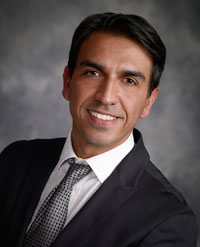
Remote LiDAR Station Featured on Cover of Atmosphere Journal

Recent research from Dr. Giacomo Valerio Iungo, assistant professor of mechanical engineering, was featured on the cover of the journal Atmosphere in August and included a related article. The cover features an image of Iungo’s mobile LiDAR station, which was deployed at Galveston Island State Park from November 2018 to April 2019.
The LiDAR station collected data for nearly six months on marine wind and air conditions and will be used to replicate conditions at The University of Texas at Dallas’ state-of-the-art Boundary Layer and Subsonic Tunnel (BLAST) wind tunnel, which was designed by Iungo. The WindFluX laboratory in the Erik Jonsson School of Engineering and Computer Science will study the effects of pollution, specifically that might spread through the atmosphere following an oil spill event.
“This research is multidisciplinary in nature,” Iungo said. “We’re thinking about restoration, creating a future emergency plan and tracking morbidity related to the Deepwater Horizon spill. All of these will be affected by the marine atmospheric conditions.”

Following the catastrophic BP Deepwater Horizon oil spill in 2010, scientists focused primarily on solid oil floating in the Gulf of Mexico and its immediate effects on the marine environment. However, the airborne transport of petrochemicals correlates with increased rates of respiratory diseases, such as asthma, along the Gulf Coast.
Iungo and his team in collaboration with Dr. Di Yang from the University of Houston are determining where—and how far—such chemicals will travel so they can provide better warnings in the event of another environmental disaster. The researchers then developed and tested downscaled setups in the BLAST wind tunnel in order to account for multiple variances such as changes in wind, waves and other disturbances which occur in a marine environment.
“At the end of all this, we’ll have a better tool to protect the environment,” Iungo said. “Our main contribution is our mobile LiDAR station—new technology, new skills and 24-hour remote monitoring. We’re not limited by geography, as long as we have an internet connection, and we can improve the accuracy of our predictions. Ideally, we could eventually have a network of these instruments as the technology becomes cheaper and more reliable.”
The research is funded by the National Academy of Sciences through the Gulf of Mexico Research Initiative.







